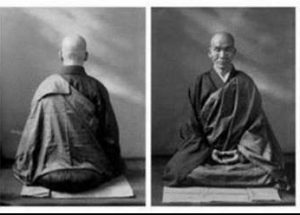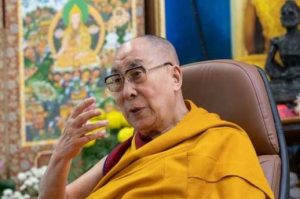
The unbroken lineage of Pure Land: interpretation and transmission
In the Dabhumi-vibhasa Shastra, Nagarjuna Bodhisattva, who lived sometime in the first century CE, identified Amitabha’s Fundamental Vow, the 18th Vow, as the source and lifeline of the Pure Land teaching. Based on this lifeline, Nagarjuna classified the Pure Land teaching as the Easy Path, or the Path of Easy Practice. He differentiated this path from all other bodhisattva teachings, the latter being the Difficult Path, or the Path of Difficult Practice.
Nagarjuna did not elaborate on the ease of Amitabha-mindfulness, particularly name-recitation, in his Dabhumi-vibhasa Shastra. In order to form a complete theoretical framework for the Pure Land teaching, Vasubandhu Bodhisattva (c. 320–400 CE) wrote the Upadesa on the Infinite Life Sutra (commonly known as the Treatise of Rebirth).
In the Upadesa, Vasubandhu establishes the practices of the Pure Land teaching, the Fivefold Amitabha-mindfulness: Amitabha-prostration, Amitabha-praise, Amitabha-aspiration, Amitabha-observation, and Amitabha-dedication. Vasubandhu also played an important role in setting up the structural framework of the Pure Land School, including theory and practice, the aptitude of practitioners, the benefits attained, and so on.
As stated by Vasubandhu in the Upadesa, he follows the original Pure Land sutras uttered by the Buddha to depict the inconceivable merits and virtues adorning the Land of Bliss, which are actually consolidated in the form of the Namethat can be recited.
The real merits and virtues contained in the other-power practice of Name-recitation, and those attained through the self-powered practices of meditative and non-meditative virtues, are regarded as a kind of “classification or demarcation of the Pure Land teaching.” This means that there are two types of benefits to be attained—one based on other-power and the other based on self-power. This is similar to the Easy and Difficult Paths as classified by Nagarjuna, since both of them are based on Amitabha’s 18th Vow in the classification of the Buddhist teachings.
Explication on the “Triple Accordance” in the Treatise of Rebirth
To set up the structural framework of the Pure Land school, Vasubandhu raised three questions about “accordance” when it comes to Pure Land practice:
1. What: “with what does it accord?”
2. Why: “why does it accord?”
3. How: “how does it accord?”
The answers of the three questions are as follows:
1. It accords with the sutra;
2. Because it is the form of real merits and virtues of the Tathagata;
3. It should match the teaching of Fivefold Amitabha-mindfulness.
In the Upadesa, the teaching of Fivefold Amitabha-mindfulness, in conjunction with Singleness of Mind, constitute the hub of the entire theoretical structure of the Pure Land teaching. So it is generally accepted that the “Three Pure Land Sutras and One Upadesa” are the principal scriptures in Pure Land Buddhism.
The significance of the Treatise of Rebirth
When the Pure Land sutras and the Upadesa was transmitted to China, Master Tanluan (476–542 CE) wrote a commentary on the Treatise of Rebirth that laid a solid theoretical foundation for the establishment of an independent Pure Land school.
In the beginning of the commentary, Master Tanluan wrote:
I respectfully refer to Dabhumi-vibhasa Shastra written by Nagarjuna Bodhisattva: There are two ways for bodhisattvas to seek for Avinivartaniya, one is the Difficult Path, and the other is the Easy Path.
“The Difficult Path: It refers to the world with five kinds of turbidity, and the era without the Buddha, so it is difficult to seek for Avinivartaniya (literally, “non-retrogression”). There are many ways to elaborate the difficulties, but they can be roughly summarized as five kinds:
1. Heterodox practitioners appear to be virtuous, but they spoil the right bodhisattva teachings.
2. Sravakas are selfish and they hinder the great compassion.
3. Wicked people with no faith destroy the splendid virtues.
4. The virtuous reward is inverted and destroys pure practices.
5. Practitioners rely on “self-power” as no “other-power” can be relied on.
These scenes are found everywhere. Such practice is suffering, like walking the difficult and treacherous land route.
The Easy Path—by mere causal condition:
1. To believe the Buddha’s teaching;
2. To aspire to be reborn in the Pure Land;
3. To have recourse to the Buddha’s vow-power;
4. To attain rebirth in that Pure Land.
5. To rely utterly on the Buddha’s power.
The practitioner thus gains entry to the correct, direct, and ascertained path of Mahayana teaching. “Correct, direct and ascertained” means Avinivartaniya. Such practice is joyful, like sailing on the vast ocean.
Classification of the Pure Land teaching by Master Tanluan in the Commentary on the Treatise of Rebirth.
Master Tanluan, also basing his thought on Amitabha’s 18th Vow, classified the Pure Land teachings as “other-power” practice, while all other bodhisattva teachings are “self-power” practice. He defined the meaning of “self-power” and “other-power” at the end of his Commentary on the Treatise of Rebirth, as follows:
I will give an example to illustrate the difference between self-power and other-power. A person who is scared to fall into the Three Wretched Realms will hold the precepts. By holding precepts, he practices meditation. Through meditation, he achieves paranormal powers. With paranormal powers, he can travel freely in the continents of the four directions. This is known as “self-power.”
Or consider a traveler who is so stupid that he cannot even ride an ass. However, he joins the entourage of the flying, wheel-turning monarch, and can then travel the continents of the four directions without any difficulty or obstruction. This is known as “other-power.”
Don’t be foolish! All future learners and practitioners who hear of “other-power”should believe in it. Do not hinder yourselves, but simply avail yourselves of it.
It is clearly noted that “self-power” practices refer to the Three Learnings—Precepts, Meditation, and Wisdom, while “other-power” practice means “Amitabha-recitation,” as far as rebirth in the Land of Bliss is concerned.
The unbroken lineage signifies the proper Dharma transmitted directly from Shakyamuni Buddha. Whoever strictly follows the lineage and practice of the Pure Land teaching will be liberated from birth and death, attain the bodhisattva’s state of non-retrogression, and ultimate emancipation in buddhahood. This is true even for those of us who live in the era without the Buddha, and in the world with five kinds of turbidity.











